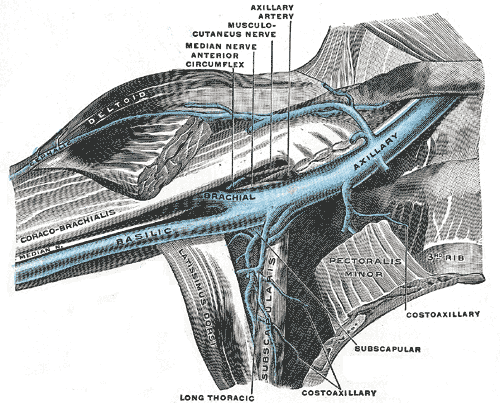Paget–Schroetter disease
| Paget-Schrotter disease | |
| Classification and external resources | |

| |
|---|---|
| Anterior view of right upper limb and thorax | |
| ICD-10 | I82.8 |
| ICD-9 | 453.8 |
| DiseasesDB | 34349 |
| eMedicine | med/2772 |
Editor-In-Chief: C. Michael Gibson, M.S., M.D. [1] Assosciate Editor(s)-In-Chief: Prashanth Saddala M.B.B.S
Synonyms and keywords: Paget-von Schrotter disease; effort-induced thrombosis; Subclavian vein thrombosis; Paget-von Schrötter syndrome; Paget-Schroeder syndrome
Overview
Paget-Schroetter disease is a form of upper extremity deep vein thrombosis (DVT), a medical condition in which blood clots form in the deep veins of the arms. These DVTs typically occur in the axillary or subclavian veins.
Historical Perspective
The condition is named after two men. James Paget[1] first proposed the idea of venous thrombosis causing upper extremity pain and swelling,[2] and Leopold von Schrötter later linked the clinical syndrome to thrombosis of the axillary and subclavian veins.[3] Paget-Schroetter syndrome was described once for a viola player who suddenly increased practice time 10-fold, creating enough repetitive pressure against the brachiocephalic and external jugular veins to cause thrombosis.[4] The syndrome also became known as "effort-induced thrombosis" in the 1960s,[5] as it has been reported to occur after vigorous activity,[6] though it can also occur spontaneously.
Pathophysiology
The pathophysiology of the syndrome involves compressive changes in the vessel wall, stasis of blood, and hypercoagulability.
Causes
- Strenuous, repetitive, upper extremity activity
- Indwelling central venous catheter
- Total parenteral nutrition
- Thoracic outlet syndrome
Risk Factors
- Vigorous repetitive arm activity such as playing baseball or tennis.
Epidemiology and Demographics
The condition is relatively rare.[7] It usually presents in young and otherwise healthy patients. It occurs more often in males than females.
Natural History, Complications and Prognosis
- Pulmonary embolism can occur (20% – 36% of patients)
- Superior vena cava syndrome
- Thoracic outlet obstruction
- Pulmonary hypertension
- Chronic venous insufficiency
Diagnosis
Symptoms
- Sudden onset of pain in the dominant arm that is worsened with activity
- Warmth, redness, blueness and swelling in the arm.
Ultrasound
Ultrasonography is the screening test of choice. It is not very sensitive. If the test is negative, but a strong clinical suspicion remains, other imaging modalities should be used.
Venography
Venography is the most sensitive and specific study for diagnosis.
Treatment
Pharmacologic
The traditional treatment for thrombosis is the same as for a lower extremity DVT, and involves anticoagulation with heparin (generally low molecular weight heparin) with a transition to warfarin. Thrombolytic therapy may be used within 5 to 7 days of presentation.
Surgical Therapy
If there is an underlying anatomic basis for the syndrome, surgery is preferred.
- First-rib resection
- Balloon angioplasty and/or stenting of thesubclavian vein may reduce symptoms
References
- ↑ Template:WhoNamedIt
- ↑ Paget J (1866). "On gouty and some other forms of phlebitis". St. Bartholomew's Hospital Reports. 2: 82–92.
- ↑ L. von Schrötter. Erkrankungen der Gefässe. Nothnagel’s Handbuch der speciellen Pathologie und Therapie, 1901. Volume XV, II. Theil, II. Hälfte: Erkrankungen der Venen. Wien, Hölder, 1899: 533–535.
- ↑ Reina, Nick J.; Honet, Joseph C.; Brown, William; Beitman, Max; Chodoroff, Gary (1988). "Paget-Schroetter syndrome in a viola player". Medical Problems of Performing Artists. 3 (1): 24.
- ↑ Drapanas, T; Curran, WL (1966). "Thrombectomy in the treatment of "effort" thrombosis of the axillary and subclavian veins". Journal of Trauma (6): 107.
- ↑ Flinterman LE; Van Der Meer FJ; Rosendaal FR; Doggen CJ (2008). "Current perspective of venous thrombosis in the upper extremity". Journal of Thrombosis and Haemostasis. 6 (8): 1262–6. doi:10.1111/j.1538-7836.2008.03017.x. PMID 18485082. Unknown parameter
|month=ignored (help) - ↑ Hughes, ES (1949). "Venous obstruction in the upper extremity; Paget-Schroetter's syndrome; a review of 320 cases". Surg Gynecol Obstet. 88 (2): 89. PMID 18108679. More than one of
|pages=and|page=specified (help)